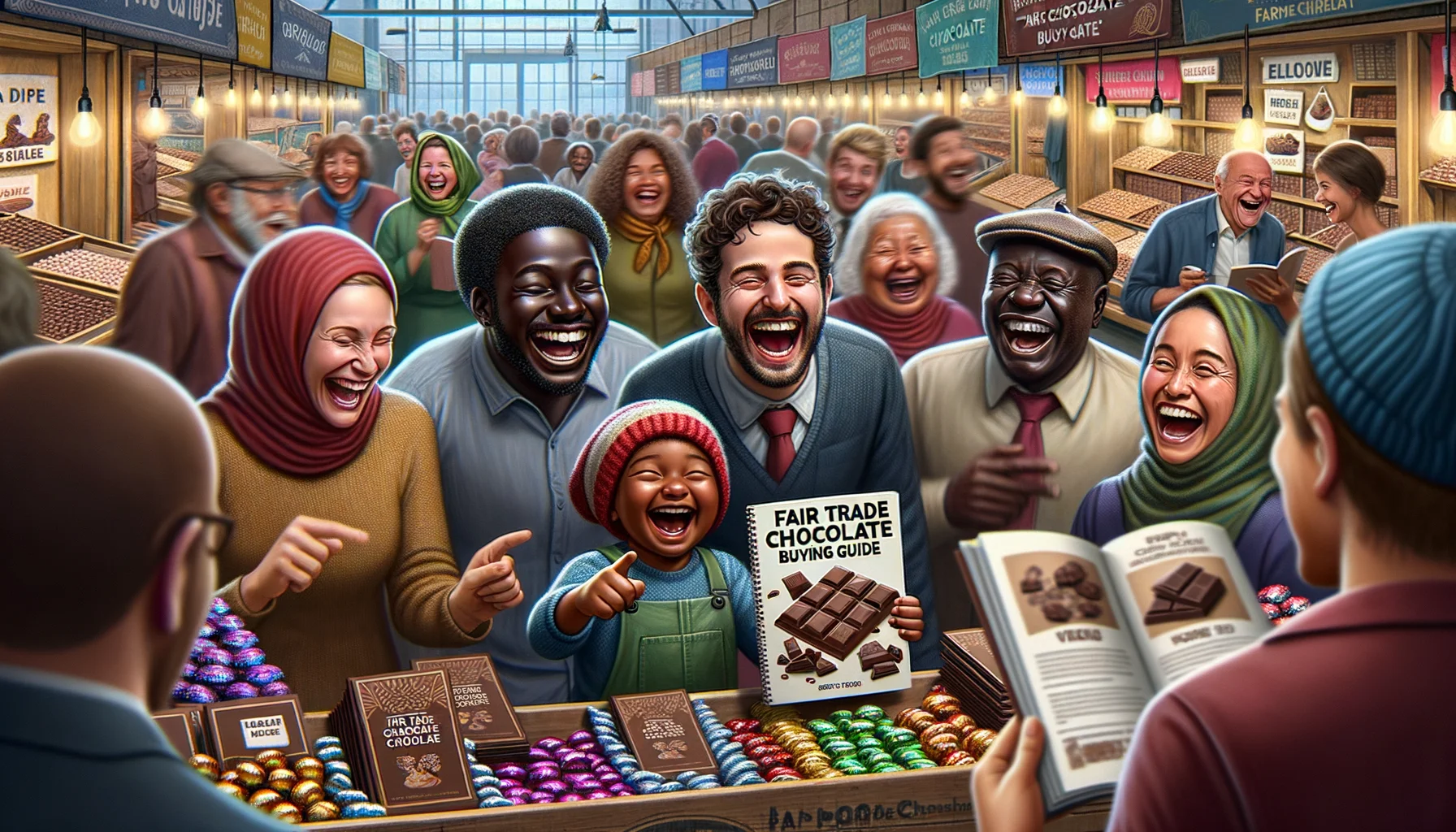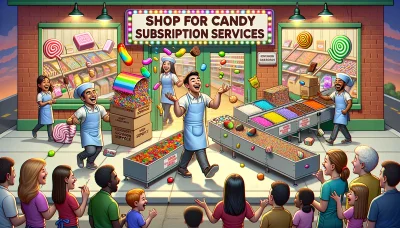Fair Trade Chocolate Buying Guide Quiz
Test Your Knowledge
Question of
Understanding Fair Trade Chocolate
Have you ever bitten into a square of chocolate and wondered about the journey it took to reach your tastebuds? That rich, velvety texture and deep, soulful flavor is not just a product of craftit's also a narrative of fairness and respect for those who cultivate the cocoa. Fair Trade chocolate is more than a label; it's a story of connection, from the hands that tend to the cacao trees to the smile that blooms on your face with each indulgent bite.
Imagine, if you will, a world where every chocolate bar cradles a legacy of positive impact. This is what Fair Trade aims to achieve. It's an invitation to become part of a movement that values people and the planet with the same fervor we reserve for our favorite treats. By choosing Fair Trade chocolate, you're casting a vote for sustainable practices and equitable trade relationships. It's like sending a thank you note across the globe with every purchase.
Let me tell you, there's something incredibly empowering about knowing that your choice of chocolate can help uplift communities. It adds an extra layer of sweetness to each morsel, doesn't it? So let's unwrap this concept together and discover why Fair Trade chocolate is more than just an ethical choiceit's a celebration of humanity in every bite.
What is Fair Trade?
The essence of Fair Trade lies in its commitment to offer better prices, decent working conditions, and fair terms of trade for farmers and workers. Its like extending a hand of friendship across continents to those who nurture the crops that add such delight to our lives. Can you feel their stories melt into your heart as the chocolate melts in your mouth?
Principles of Fair Trade
Fair Trade is underpinned by several key principles designed to empower producers and promote sustainability. These include ensuring safe working conditions, prohibiting child labor, respecting cultural identity, and fostering environmentally friendly practices. Imagine these principles as ingredients in the recipe for conscientious consumption each one essential for crafting the perfect bar of moral satisfaction.
Impact on Producers
The impact on producers is profound. For them, Fair Trade is like rays of sunshine after a stormy season it brings hope and prosperity. Through this system, farmers receive fair compensation which enables them to invest in their communities and improve their livelihoods. When we indulge in Fair Trade chocolate, we're not just savoring flavors; we're nourishing futures.
Benefits of Choosing Fair Trade Chocolate
In my personal reverie with these divine confections, I've often found that choosing Fair Trade chocolate enriches not only my palate but also my spirit. The knowledge that each piece supports equitable trade makes each nibble taste like justice itself.
Ethical Considerations
To choose Fair Trade is to embrace empathy with your taste buds. Its about connecting with global citizens through the universal language of chocolate while standing against exploitation and inequality. Each time we select these ethically sourced treasures, we're weaving threads of dignity into the tapestry of global commerce.
Quality and Craftsmanship
But lets not forget about quality! Oh no! The craftsmanship behind Fair Trade chocolates often surpasses their conventional counterparts because when artisans are empowered and respected, they pour their hearts into their creations. The result? A symphony for your senses where each note is composed with care and respect.
Certification and Labels
Ahh, certificationsthose little badges of honor that adorn chocolate packaging like medals on a general's uniform! They tell tales of authenticity and integrity but navigating this landscape requires some know-how.
Recognizing Authentic Certifications
- Fairtrade International (FLO): A widely recognized emblem symbolizing strict adherence to international Fair Trade standards.
- Rainforest Alliance: A green frog emblem indicating sustainable farming practices that protect both wildlife and workers.
- UTZ Certified: Now part of Rainforest Alliance, this label stands for sustainable farming and better opportunities for farmers.
Decoding Label Information
Decoding labels can sometimes feel like unraveling an ancient script written in cryptic symbols. However, fear not! With a bit of practice, it becomes second nature to spot authentic certifications amidst a sea of marketing jargon. Look beyond flashy graphics; seek out those marks that guarantee youre supporting sound ethical practices with every delicious bite.
The Origins of Fair Trade Chocolate
Ah, chocolate that heavenly concoction that has the power to lift spirits and add a touch of luxury to the everyday. But behind every sumptuous bite lies a tale not just of taste but of ethics and origins. Fair trade chocolate is more than a label; it's a story of sustainability, equity, and indulgence intertwined. Lets unwrap this narrative together, shall we?
The journey begins in the lush tropics where cacao trees flourish under the canopy, cradled by rich soils and warm climates. Each pod harbors potential bliss, destined to become the chocolate that melts so tenderly on your tongue. But before it reaches your palate, there's a world of care and commitment that goes into ensuring that this treat is as kind to its producers as it is delightful to its consumers.
Cocoa Farming Regions
Envision the equatorial belt - it's here that cacao trees spread their roots in countries like Cte d'Ivoire, Ghana, and Ecuador. These regions are like different artists painting with the same palette but creating distinct masterpieces. Each locale imparts its signature brushstrokes - subtle nuances in flavor and aroma - making every regions cocoa beans unique.
In West Africa, where bulk production reigns, you'll find robust flavors often described as hearty and full-bodied. Cross the ocean to South America, and you're greeted by notes that dance between fruity and floral - a complexity beloved by connoisseurs. And let's not forget about Southeast Asia's contribution: a delicate balance of earthy tones married with an unexpected hint of spice.
Characteristics of Different Regions
- West Africa: Bold, classic chocolate flavors with a strong cocoa foundation.
- South America: A symphony of intricate notes ranging from berry-like to nutty undertones.
- Southeast Asia: A fusion of earthiness accented with peppery zing.
Climate and Cocoa Quality
The climate whispers secrets to the cacao beans; tales of sun-drenched days and tropical showers. This dialogue shapes each bean's character from its resilience in facing pests to its capacity to develop those sought-after flavors. Climate isn't just about weather; its about terroir that French term we borrow to express how environment stamps its identity onto what grows within it.
For fair trade chocolate enthusiasts, this isnt just trivia; its essential knowledge. Its understanding why each bite carries with it an echo of rainforest mists or arid breezes a terroir-tailored treasure trove for your taste buds.
From Bean to Bar: The Production Process
Delve deeper into this confectionery world, past the initial allure of exotic locales, and you'll find yourself amidst the alchemy that transforms bean into bar. This process is one part science, one part artistry all parts passion. And in fair trade chocolate making, every step is infused with an extra dollop of care for both people and planet.
From harvest rituals passed down through generations to the meticulous methods honed over centuries, each phase in this chain is pivotal in sculpting chocolate's final form one that aims to honor both its heritage and future sustainability.
Harvesting and Fermentation
Harvesting cacao pods is no mindless task; it's an art requiring precision and timing plucking each pod only when ripe for optimal flavor development. Then comes fermentation, natures own little miracle where beans are coaxed into revealing their hidden profiles through days of patient waiting under banana leaves or burlap sacks.
Tasting and Enjoying Fair Trade Chocolate
Embarking on the journey of tasting fair trade chocolate is akin to entering a secret garden, where every turn unveils a new aromatic bloom. Each square is not just a treat; it's an ethical embrace, a whisper of empowerment to the farmers who cultivate the cocoa with care. The flavors are as rich in variety as the stories behind themstories of sustainable practices and equitable trade.
As you let that first piece melt on your tongue, close your eyes and savor the slow dance of bittersweet, floral, and earthy notes. Fair trade chocolate isn't just a confectionery delight; it's a global connection, a shared commitment to fairness and quality. It's about finding joy in the little things, like how a simple square of chocolate can mean so much more than its taste.
Flavor Profiles and Varieties
Every fair trade chocolate bar comes with its own personality, shaped by its origin, cocoa content, and craftsmanship. From the dark and intense to the smooth and creamy, there's an endless spectrum to explore. The flavor profiles range from fruity to nutty, each with its own tale to tell. Some bars might hint at red berries or tropical fruits, while others take you on a woody adventure with whispers of oak or pine.
The varieties are plentifulthere are single-origin chocolates that celebrate the unique characteristics of their birthplace; blends that harmonize different beans into symphonies of flavor; and even infusions that playfully mingle spices, herbs, or teas with cocoa's versatile canvas. This delightful diversity invites us not just to taste but to embark on an exploratory quest for our palate's true passion.
Understanding Cocoa Content
Cocoa content is like the heartbeat of chocolateit dictates the rhythm of flavor that pulsates through each bite. High cocoa content usually heralds a robust intensity, a bold statement of pure chocolate essence that resonates with aficionados seeking depth and complexity. On the other end, lower cocoa content offers a gentler experience where sweetness cradles the cocoa in a tender lullaby.
Understanding cocoa percentages is key to selecting your ideal chocolate experience. It's about balancing richness with sweetness, intensity with approachability. As you navigate through percentages, remember that high numbers don't always equate to superior qualityits about finding harmony between cocoa content and your personal taste preferences.
Pairing with Foods and Beverages
Pairing fair trade chocolate with foods and beverages is like composing music; it's about creating harmony between contrasting notes. A rich dark chocolate might find its match in the boldness of a full-bodied wine or the sharp tang of aged cheese. Milkier varieties often sing alongside fruits like strawberries or bananas, creating duets that resonate with sweetness and texture.
- Coffee: Pairing coffee with chocolate intensifies both their flavors.
- Tea: A delicate tea can highlight subtle nuances in lighter chocolates.
- Fruit: Citrus or berries offer a refreshing counterpoint to rich cocoa.
- Nuts: Almonds or hazelnuts add crunch and complementary flavors.
- Cheese: A slice of sharp cheese can balance sweet milk chocolate beautifully.
- Wine: Red wines pair well with darker chocolates for a luxurious experience.
Your palate becomes the canvas upon which these pairings dancea sip here, a nibble thereeach combination painting new strokes of flavor across your taste buds. Embrace experimentation; sometimes its those unexpected pairings that create the most memorable experiences.
The Art of Chocolate Tasting
The art of chocolate tasting is akin to poetry without wordsit's about feeling rather than articulating, sensing rather than analyzing. Engaging all your senses allows you to fully immerse yourself in this indulgent ritual. Begin by examining its appearance; let your eyes feast upon its glossiness and hue before breaking off a pieceto hear that satisfying snapand taking in its aroma as if it were fine perfume.
To taste is to unravel layers upon layers of flavor as they unfold across your tonguea slow waltz where each step reveals something new: perhaps an unexpected spice or an undercurrent of caramelized sugar. Allow yourself this momentary escape from reality where nothing exists but you and this exquisite piece of fair trade artistry melting slowly in your mouth.
Engaging Your Senses
To truly engage your senses when tasting fair trade chocolate is to be present in the momentto shut out the world and focus solely on this small luxury nestled between your fingers. Feel its texture: is it velvety smooth or intriguingly gritty? Listen as it breaks: does it whisper or proclaim? Inhale deeplythe scent alone can transport you to distant lands where cacao trees sway gently in tropical breezes.
Taste buds awaken as they're bathed in rich cocoathe initial notes might be bold or subtle, but they pave the way for more intricate flavors hidden beneath. Theres joy in discovery herea reminder that lifes greatest pleasures often lie in simplicity and mindfulness.
Identifying Subtle Flavors
The subtleties within fair trade chocolate are like secrets waiting to be discovered by those who take the time to listen closely enough. Identifying these nuances isn't just about expertiseit's about letting go and allowing yourself to be surprised by what emerges from within this humble square of goodness: perhaps hints of vanilla wafting through dark intensity or a touch of sea salt tickling milk chocolate sweetness.
This practice teaches patience; not all flavors shout their presencethey prefer instead to whisper softly until they're noticed by those willing enough to seek them out. It reminds us that often what may seem inconsequential can hold profound beauty if only we pay attention.
Storing Your Chocolate
The sanctity of storing your fair trade treasure cannot be understatedit is an act akin to tucking away precious jewels for safekeeping. Ideal conditions for preservation involve cool temperatures away from sunlight because just like fine wine, chocolate too can age gracefully under proper careor wilt sadly if neglected.
A consistent temperature around 65F (18C) strikes the perfect balance between too warm (which risks melting) and too cold (which could result in sugar bloom). A dry environment also plays an essential role because moisture is an enemy capable of dulling both texture and flavor over timea fate no chocolate deserves!
Ideal Conditions for Preservation
Finding those ideal conditions for preserving your fair trade chocolates requires some finessea dedicated drawer perhaps or even better: a specialized storage box meant solely for these artisanal creations. Light exposure should be minimized as UV rays have no place meddling with such delicate profiles; darkness becomes their protective cloak ensuring longevity in peak condition.
Avoid strong odors as well since chocolates are impressionable soulsthey absorb scents around them which could lead them astray from their true aromatic path. Treat them kindlywith respectand they will reward you tenfold each time you revisit their complex charm.
Tips for Long-Term Storage
If you're looking towards long-term storageperhaps saving some special bars for future moments of reflection or celebrationthen consider double-wrapping them tightly against air exposure which can stale even the most resilient spirits over time. Aluminum foil followed by plastic wrap provides dual layers of defense against external threats while still honoring their internal beauty waiting patiently beneath wraps until its time once again for indulgence!
In conclusion (though we never truly conclude when it comes to savoring such delights), storing fair-trade chocolates isnt just practicalityits part reverence too because each bar encapsulates not only exquisite flavors but also hope: hope for better livelihoods through ethical choices made one delicious bite at a time!
Health Benefits of Fair Trade Chocolate
When I think of chocolate, my mind drifts to that velvety sensation as it melts on my tongue, the rich aroma that fills the air, and that sweet, indulgent flavor that seems to hug my soul. But beyond its ability to transport us to our happy place, there's a whole world of benefits nestled within fair trade chocolate that makes this treat not just a guilty pleasure but a delightful ally to our health.
Nutritional Content Overview
Let's unwrap this cocoa confection and peek into its nutritional content. It's like finding out your favorite superhero has a secret identity except this hero wears a cape made of antioxidants and vitamins. Fair trade chocolate isn't just about equitable pay and sustainable farming; it's also about what it gives our bodies in return for the joy it brings.
Antioxidants in Cocoa
The cocoa bean is a sneaky little powerhouse. It's teeming with antioxidants those valiant little warriors that fight off free radicals like microscopic superheroes. Flavanols are the stars here; they're the same compounds found in red wine and green tea, making dark chocolate an undercover health food. Every bite feels like I'm donning an antioxidant armor, ready to face the world with vigor.
Vitamins and Minerals Present
But wait, there's more! Magnesium, iron, copper these aren't just elements on the periodic table; they're key nutrients hiding in those luscious squares of fair trade chocolate. It's like each piece is whispering, "I'm here for your heart, your blood, your energy levels." A little nibble can be a love letter to your body.
Dark Chocolate and Heart Health
Sometimes I imagine dark chocolate as a love potion for my heart not just metaphorically speaking. There's science behind those sweet whispers promising eternal affection for our cardiovascular system.
Research on Cardiovascular Benefits
I've read papers where researchers donned lab coats and goggles just to tell us what we hoped was true eating dark chocolate can be akin to sending bouquets of flowers to our arteries. The flavonoids help keep things flowing smoothly, like a love ballad that keeps the rhythm of our hearts steady and strong.
Recommended Consumption
But before you start hoarding bars like they're going out of style, let's talk dosage. A square or two a day is enough to serenade your heart without overwhelming it with sugar. Its all about moderation like enjoying the chorus without blasting the song on repeat all day long.
Chocolate and Mental Wellbeing
Ah, mental wellbeing that elusive state where everything feels as smooth as melted chocolate. It turns out; our favorite treat has a part to play in this too.
Mood-Enhancing Effects
I don't need science to tell me that chocolate lifts my spirits one taste of its creamy goodness does more for my mood than any pep talk ever could. But apparently, there are natural compounds in cocoa that tickle the brain in all the right places, releasing those feel-good chemicals we all crave.
Stress Reduction Properties
And when life turns up the heat and stress bubbles over like boiling fondue? Chocolate steps in as a calming friend, offering its stress-reducing properties like a soothing melody or a gentle pat on the back. Its not magic; its chemistry and maybe a bit of alchemy from Mother Nature herself.
In every morsel of fair trade chocolate lies a narrative richer than its taste one of health benefits wrapped in ethical practices and sustainable growth. Next time you indulge, take a moment to savor not just the flavor but also the story behind each square your body (and your conscience) will thank you.
Ethical Considerations in Chocolate Consumption
There's something deeply personal about the way chocolate melts on your tongue, isn't there? It's like a whispered promise of joy, a tender caress for your taste buds. But behind the velvety richness of every square lies a narrative that stretches far beyond our immediate senses. As we peel back the layers of foil, it's crucial to consider the ethical implications that come with our chocolate indulgence.
The journey of cocoa beans is complex and often shadowed by practices that tug at the conscience. From the hands that harvest to the methods employed in cultivation, each step is imbued with moral significance. The blissful ignorance that once enshrouded our chocolate experience is slowly melting away, revealing the bittersweet realities of the industry.
Labor Practices in Cocoa Production
The path from bean to bar is fraught with labor issues that can no longer be ignored. Those delightful bites we savor are frequently harvested by individuals whose lives are starkly different from our own. Reports of child labor in cocoa production have surfaced over the years, painting a grim picture of exploitation and lost childhoods. These young souls work in conditions where laughter and learning should fill their days, not the relentless demands of cocoa cultivation.
Moreover, fair wages and working conditions for adult workers remain elusive in many regions. Imagine laboring under the relentless sun, your hands stained with earth and sweat, only to receive compensation that barely sustains your family. It's a reality that weighs heavily on my heart whenever I unwrap a chocolate bar. We owe it to these diligent workers to seek out products that honor their labor with equitable pay and humane working conditions.
Child Labor Issues
- Prevalence of underage workers in cocoa farms
- Risks and hardships faced by child laborers
- Movement towards eradicating child labor in chocolate production
Fair Wages and Working Conditions
The whispers of conscience grow louder as we delve into fair wages and working conditions within cocoa farms. To indulge in chocolate should not come at the cost of someone else's wellbeing. Fair Trade certification emerges as a beacon of hope here, ensuring that farmers receive a sustainable price for their crops, allowing them to invest back into their communities and improve their quality of life.
Environmental Impact of Cocoa Farming
As I bite into a chunk of dark chocolate, I can't help but think about the land where its ingredients came from. The environmental impact of cocoa farming is an intricate part of this sweet equation. Sustainable farming practices are essential to maintain balance within ecosystems; otherwise, we risk stripping the earth of its ability to provide for future generations.
The health of our biodiversity hangs in balance as well. Cocoa farming done irresponsibly can lead to deforestation, threatening countless species and disrupting habitats. It's akin to playing a discordant note in nature's symphonysomething we must strive to correct for harmonys sake.
Sustainable Farming Practices
Sustainable farming practices include shade-grown cocoa which supports bird populations and reduces deforestation rates, maintaining an ecological balance necessary for both wildlife and agriculture to thrive side by side.
Biodiversity and Ecosystem Health
Biodiversity is like nature's tapestry; each thread interwoven with care and purpose. Cocoa farms that respect this intricate web contribute positively to ecosystem health, ensuring that every creaturefrom the tiniest insect pollinators to the majestic forest dwellersplays its part without threat from agricultural encroachment.
Community Empowerment through Fair Trade
I remember biting into a piece of Fair Trade chocolate; somehow it tasted richer knowing it supported something more than just my craving. Community empowerment through Fair Trade isn't just about ethical consumptionit's about stories unfolding across oceans, stories where education flourishes instead of faltering under financial strain.
Infrastructure development goes hand-in-hand with these efforts, creating roads not just paved with asphalt but also opportunityopportunity for children to attend schools built from cooperative funds or families accessing healthcare facilities funded by fairer trading principles.
Education and Healthcare Improvements
To empower communities is to offer them keys to unlock potentialpotential found within classroom walls where education blooms like flowers after rain or within healthcare centers where wellness is nurtured like seedlings reaching for sunlight.
Infrastructure Development
Infrastructure development stands as testamenta testament carved out of improved living standards where clean water flows freely from taps made possible by fair prices paid for cocoa pods cradled gently in farmers' calloused hands.
How to Choose the Best Fair Trade Chocolate
There's something about the ritual of unwrapping a bar of chocolate that feels almost sacred. The anticipation builds as you hear the crinkle of paper or foil, giving way to that first glimpse of glossy brown richness. It's more than a treat; it's a moment, an experience. But when that chocolate carries a Fair Trade label, the indulgence takes on an additional layer of satisfaction, knowing that you're supporting ethical practices and sustainability. So how does one navigate this world of responsible indulgence? Let us delve into the art of choosing not just good chocolate, but great Fair Trade chocolate.
Reading Ingredient Lists
The first step in my chocolate quest always begins with flipping over the bar to scrutinize its ingredients. You see, high-quality chocolate is quite the purist at heart it doesn't need much to shine. Typically, a short list is a promising sign, signaling that each component is there because it needs to be, not because it was cheaper or easier for mass production.
Identifying Quality Ingredients
When I scan the ingredient list, I'm looking for cocoa content front and center it's the soul of any chocolate bar. The cocoa should come from beans known for their superior flavor profiles; think Criollo or Trinitario varieties. Then there's the sweetener - organic cane sugar holds its own against other options. I also look out for real vanilla instead of vanillin; its like catching a whiff of pure harmony in scent form.
Avoiding Unwanted Additives
I've learned to be wary of long ingredient lists where sugar leads the parade and artificial flavors are invited to dance along. Emulsifiers like soy lecithin aren't deal-breakers but remind me that sometimes simplicity is lost in translation from bean to bar. And hydrogenated oils? They're the uninvited guests at my chocolate party.
Packaging and Presentation
Ah, packaging the silent storyteller of any chocolate bar. It's not just about looking pretty; it's about respect for whats inside and outside both the product and our planet.
Eco-Friendly Packaging Options
I've found myself more drawn to brands that put thought into their packaging materials - recyclable papers, biodegradable wrappers, or even compostable foils. It speaks volumes about a company when they ensure their environmental footprint is as light as their chocolate is rich.
Design and Brand Storytelling
The design isn't just eye candy; it's part of a brand's soul speaking to you before you've even tasted their creation. I adore when there's a story woven through the visuals perhaps hinting at origins or illustrating the journey from bean to bar. The narrative doesn't just sell me a product; it invites me into a world.
- The intricate artwork reminiscent of cacao-growing regions
- Tactile papers that beg to be touched
- Typography that tells of tradition and modernity intertwined
Price Considerations and Value for Money
I won't pretend that price isn't a factor when selecting my Fair Trade chocolate after all, we're not all made of money (or cocoa beans). Yet, theres something deeply satisfying about investing in quality that promises more than just taste.
Understanding Price Points
Diving into this confectionery world has taught me that price often reflects more than just what meets the tongue. It encompasses fair wages for farmers, investment in sustainable farming practices, and sometimes direct support for community projects in cacao-producing areas.
Balancing Cost and Quality
Finding balance between cost and quality means acknowledging that sometimes you get what you pay for a richer flavor profile, a smoother texture, an assurance that every bite supports ethical trade practices. And isnt there something undeniably beautiful about knowing your treat has treated others well?
In savoring these chocolates, I've learned life lessons far beyond discerning notes of fruit or nuts within each bite. Each square carries stories - stories of distant lands where cacao trees grow under tropical canopies, stories of farmers whose lives are intertwined with each harvest, stories that we become part of with every piece we enjoy.
Choosing Fair Trade chocolate is not just about satisfying our sweet tooth; its about participating in an act of global connection and responsibility one delicious nibble at a time.
Incorporating Fair Trade Chocolate into Your Lifestyle
Cooking and Baking with Fair Trade Chocolate
There's something almost magical about melting a bar of rich, dark chocolate between your fingersthe slight resistance before it yields to the warmth of your touch, the glossy sheen as it starts to give way. When I bake with Fair Trade chocolate, I'm not just crafting a dessert; I'm stirring a little bit of that magic into every bite. Each square carries with it stories: of farmers who are fairly compensated, of sustainable practices that nurture our earth, and of a consumer choice that echoes through lives and landscapes.
Selecting the Right Type for Recipes : It's like choosing the perfect spell for the potion you're brewing. A flourless chocolate cake demands a bittersweet variety, rich and deep, while those chewy cookies might call for semi-sweet chips that hold their shape under the alchemy of heat. And let's not forget white chocolatethough a rebel in the cacao familyit brings its own brand of creamy enchantment to ganaches and frostings.
Tips for Best Baking Results : Remember, good wizards never rush their spells. Take your time melting chocolate over a double boilernever directly on the flame. And if you're conjuring up confections like truffles or bonbons, tempering is key; it's the secret to that satisfying snap and lustrous finish. Measure meticulously, friends; baking is as much science as it is art when you're weaving in such potent ingredients.
Gifting Fair Trade Chocolate
Imagine unwrapping a gift to find a bar of Fair Trade chocolate nestled insidethe smooth wrapper crinkling softly in anticipation. There's an intimacy in gifting chocolate; it's personal, thoughtful. You're not just passing along a commodity but sharing an experience: one that pleases the senses and uplifts the spirit.
Occasions for Chocolate Gifts : Birthdays that beg for sweetness, anniversaries that whisper of shared delights, or simply because moments where no reason is needed at all. And when holidays roll around? A basket brimming with ethical treats speaks volumes about lovenot just for those we hold dear but also for our global community.
- Valentines Day: Heart-shaped boxes filled with ethical indulgence.
- Christmas: Advent calendars counting down days with bites of joy.
- Easter: Eggs and bunnies symbolizing rebirth and new beginnings.
- Thank You: A simple bar can say what words sometimes can't.
Personalizing Your Gift Selections : To personalize your gift, consider pairing chocolates with storiesthe tales of the people who grew them and their journey from bean to bar. Perhaps include a handwritten note or choose flavors that resonate with shared memories. And always remember: The best gifts are those given with intention and savored without haste.
Supporting Fair Trade Beyond Chocolate
Our love affair with chocolate needn't end at taste buds' delight; it can be a gateway into a larger world of fair trade advocacy. When we reach for that bar adorned with the Fair Trade logo, we're casting a vote for equity in commerce, for communities thriving across oceans.
Other Fair Trade Products to Explore : It doesn't stop at cocoa beans! Think aromatic coffee that awakens more than just our mornings, teas steeped in tradition yet fresh in impact, bananas whose sweetness carries weight beyond their flesh. The list goes onhandcrafted jewelry, ethereal scarvesall threads in a tapestry of ethical consumption.
And then there's the ripple effecta pebble tossed into still watera conversation started over a mug or beneath an umbrella woven by artisans' hands. These are opportunities to spread awareness like wildfire (the good kind!), igniting minds to think beyond labels and price tags. Raising awareness can be as simple as hosting tasting parties where each nibble comes paired with knowledge or engaging in social media dialogues about fair trade impacts. Whether through education or simply by being mindful shoppers ourselveswe become advocates for change. In this small waybite by bitewe build bridges over which farmers can walk toward prosperity and consumers toward enlightenment. So next time you savor that velvety piece of chocolate bliss, let it be more than just dessert; let it be part of a larger feasta feast for fairness. Indulge wisely. Savor fully. Advocate passionately. And remember: In every morsel of Fair Trade chocolate lies an invitationto taste not only flavor but possibility. Enjoy responsibly. Share generously. Live deliciously. And may every sweet treat be both pleasure\.and purpose.











